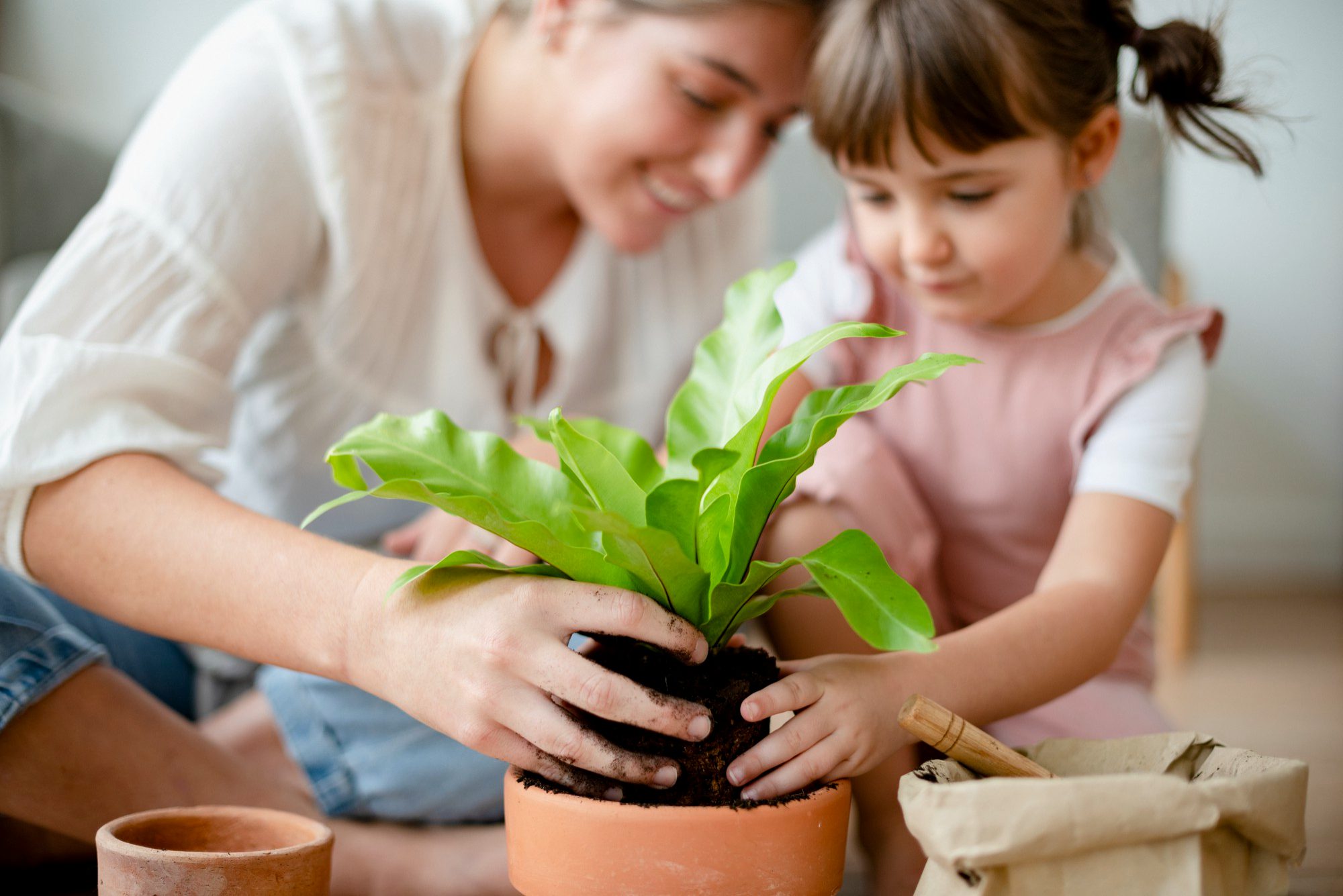
Introducing your children to the wonders of nature and the importance of the environment can be both fun and educational. Engaging children in plant care activities not only nurtures their love for nature but also teaches them valuable skills about responsibility and sustainability.
In this guide, I will share some exciting and educational indoor gardening activities that you can do with your kids.
Key Takeaways:
- Gardening with kids is a great way to teach them about plants and the environment.
- Indoor gardening activities can be fun, educational, and family-friendly.
- Engaging children in plant care helps develop their love for nature and sustainability.
- There are many creative and engaging ways to involve kids in indoor gardening.
- Teaching kids about responsibility and scheduling through plant care tasks can be beneficial.
Activity 1: Seed Germination Experiment
One of the most exciting and educational activities you can do with your children is a seed germination experiment. This hands-on gardening activity for kids allows them to observe the wonders of plant growth and learn about the essential factors that contribute to the germination process.
Through this experiment, children can develop a deeper understanding of the importance of water, sunlight, and air for plant growth.
To conduct the seed germination experiment, you will need:
- Seeds of various plants
- Plastic cups or small pots
- Potting soil
- A water spray bottle
- Plastic wrap or bags
- Labels
Start by having your children plant the seeds in the plastic cups or small pots filled with potting soil. Encourage them to label each cup or pot with the plant name for easy identification. Then, instruct them to water the seeds lightly using the water spray bottle.
Cover the cups or pots with plastic wrap or bags to create a humid environment for germination. Place the cups or pots in a warm and sunny spot, ensuring they receive adequate sunlight.
Over the next few days, your children can observe the germination process and record their observations. Encourage them to document the changes they see in each seed, such as the appearance of roots and sprouts.
This activity not only teaches children about plant growth but also cultivates their patience and curiosity as they eagerly await the transformation of a tiny seed into a thriving plant.
| Materials Needed | Instructions |
|---|---|
| Seeds of various plants | Choose a variety of seeds to explore different plant species and characteristics. |
| Plastic cups or small pots | Provide containers for planting the seeds. Cups or pots should have drainage holes for proper water flow. |
| Potting soil | Use nutrient-rich potting soil to provide a healthy growing environment for the seeds. |
| A water spray bottle | Use a water spray bottle to ensure gentle and even watering of the seeds. |
| Plastic wrap or bags | Cover the cups or pots with plastic wrap or bags to create a humid environment that promotes seed germination. |
| Labels | Label each cup or pot with the name of the plant to track the progress and identify different seeds. |
Activity 2: Leaf Printing Art
Enhance your children’s creativity and spark their curiosity about nature with the engaging and educational activity of leaf printing art. This sensory activity allows kids to explore the diverse world of plants while creating unique and nature-inspired crafts.
Start by collecting large leaves from indoor or outdoor plants, ensuring they are clean and free from any dirt or debris. These leaves will serve as the artistic medium for this activity.
Provide your children with washable tempera or acrylic paints, paintbrushes, and paper or canvas.
Encourage them to apply paint onto the leaves, ensuring they cover the entire surface. Then, carefully press the painted leaves onto the paper or canvas, applying gentle pressure to transfer the intricate patterns and textures of the leaves onto the material.
This process will create beautiful and colorful prints that showcase the unique characteristics of different types of leaves.
| Benefits of Leaf Printing Art | Keywords |
|---|---|
| 1. Nature-inspired crafts for kids | nature-inspired crafts for kids |
| 2. Plant identification and characteristics | plant identification, plant characteristics |
| 3. Sensory activity for tactile exploration | sensory activity |
This activity promotes plant identification as children observe and investigate the unique characteristics of different leaves. They will learn about the shapes, sizes, and textures of leaves, developing their knowledge about plant diversity.
Additionally, the sensory aspect of the activity engages children in tactile exploration, allowing them to feel the texture of leaves and experience the delight of creating art with natural materials.
This hands-on experience fosters a deeper connection with nature and encourages appreciation for the beauty and intricacy found in plant life.
Through leaf printing art, children can unleash their creativity and gain a deeper understanding of the natural world around them.
It provides an enjoyable and educational experience that combines art, science, and nature, making it an ideal activity for kids of all ages.
Activity 3: DIY Terrarium
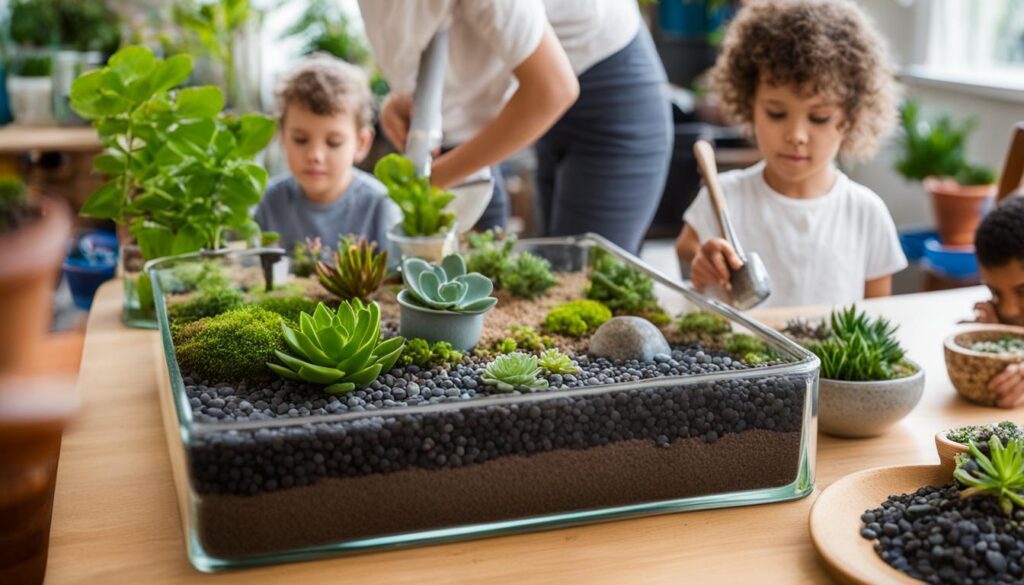
Creating a DIY terrarium is a fantastic way to engage children in indoor plant care and teach them about closed ecosystems. A terrarium is a miniature garden enclosed in a glass or clear plastic container, creating a unique and visually appealing display of indoor plants.
To get started, you’ll need a few supplies, including a glass or clear plastic container, small rocks or pebbles, activated charcoal, potting soil, small indoor plants, decorative items, and a water spray bottle.
The container can be any size or shape you prefer, as long as it can be sealed to create the enclosed terrarium environment.
First, add a layer of small rocks or pebbles to the bottom of the container. This helps with drainage and prevents water from pooling at the bottom.
Next, add a thin layer of activated charcoal, which helps to keep the terrarium fresh by absorbing any odors or impurities. Then, add a layer of potting soil, making sure it is suitable for the specific types of plants you’ll be using.
Now comes the fun part – adding the plants! Choose small indoor plants that thrive in the conditions provided by your terrarium. Succulents, ferns, and mosses are popular choices because they require minimal maintenance and can thrive in the humid environment created inside the terrarium. Arrange the plants in the soil, leaving enough space for growth.
Plant Care Routine and Interactions
Once your terrarium is set up, it’s important to establish a plant care routine. Regularly check the moisture level of the soil and water the terrarium using a spray bottle to avoid overwatering. Keep the terrarium in a location with indirect sunlight, as too much direct sunlight can cause excessive heat and damage the plants.
As your children care for their terrarium, they will start to observe the interactions between the plants and their environment. They can witness condensation forming on the sides of the container, indicating the closed ecosystem is working. They can also observe how the plants grow and potentially interact with each other, creating a fascinating mini-ecosystem right in their own home.
| Supplies | Steps | Benefits |
|---|---|---|
| Glass or clear plastic container | 1. Add small rocks or pebbles to the bottom of the container. 2. Layer activated charcoal on top of the rocks. 3. Add a layer of potting soil. 4. Arrange and plant small indoor plants. 5. Seal the container to create a closed environment. | – Creates an aesthetically pleasing indoor plant display – Teaches children about closed ecosystems – Encourages responsibility and plant care routine |
| Small rocks or pebbles | 1. Add a layer of small rocks or pebbles to the bottom of the container. | – Improves drainage – Prevents water pooling at the bottom of the container |
| Activated charcoal | 1. Layer activated charcoal on top of the rocks. | – Absorbs odors and impurities – Keeps the terrarium fresh and clean |
| Potting soil | 1. Add a layer of potting soil. | – Provides a suitable growing medium for the plants – Ensures proper root growth and nutrition |
| Small indoor plants | 1. Arrange and plant small indoor plants. | – Adds life and greenery to the terrarium – Survives well in the enclosed environment |
| Decorative items | 1. Add decorative items as desired. | – Enhances the visual appeal of the terrarium – Allows personalization and creativity |
| Water spray bottle | 1. Water the terrarium using a spray bottle. | – Provides controlled and gentle watering – Avoids overwatering and waterlogging |
Activity 4: Recycling Challenge
Engaging children in recycling activities is not only a great way to reduce waste but also to teach them about environmental conservation. The recycling challenge activity encourages kids to repurpose items and get creative with recyclables, fostering their imagination and promoting responsible waste management practices.
To conduct the recycling challenge, gather empty containers or bottles, art supplies, a timer or stopwatch, and recycling bins or bags. Set a specific timeframe for the challenge, such as 20 minutes, and let the kids use their imagination to transform the empty containers or bottles into something new and useful. They can create pencil holders, planters, or any other functional or decorative items using their artistic skills.
This activity not only teaches children about the importance of reducing waste but also encourages them to think creatively and find new uses for everyday items. By repurposing materials, they learn to appreciate the value of recycling and contribute to a cleaner and more sustainable environment.
Recycling Challenge Ideas:
- Create a bird feeder using a plastic bottle and string.
- Turn empty cardboard tubes into colorful kaleidoscopes.
- Transform old magazines or newspapers into collages or paper beads for jewelry.
- Design unique planters from plastic containers and paint them with vibrant colors.
The recycling challenge activity not only promotes environmental consciousness but also cultivates children’s creativity and problem-solving skills. It helps them understand the importance of reducing waste and encourages them to contribute positively to the world around them.
| Benefits of the Recycling Challenge Activity |
|---|
| Teaches kids about environmental conservation |
| Promotes responsible waste management practices |
| Fosters creativity and imagination |
| Encourages problem-solving skills |
| Develops a sense of responsibility towards the environment |
Activity 5: Composting Lesson
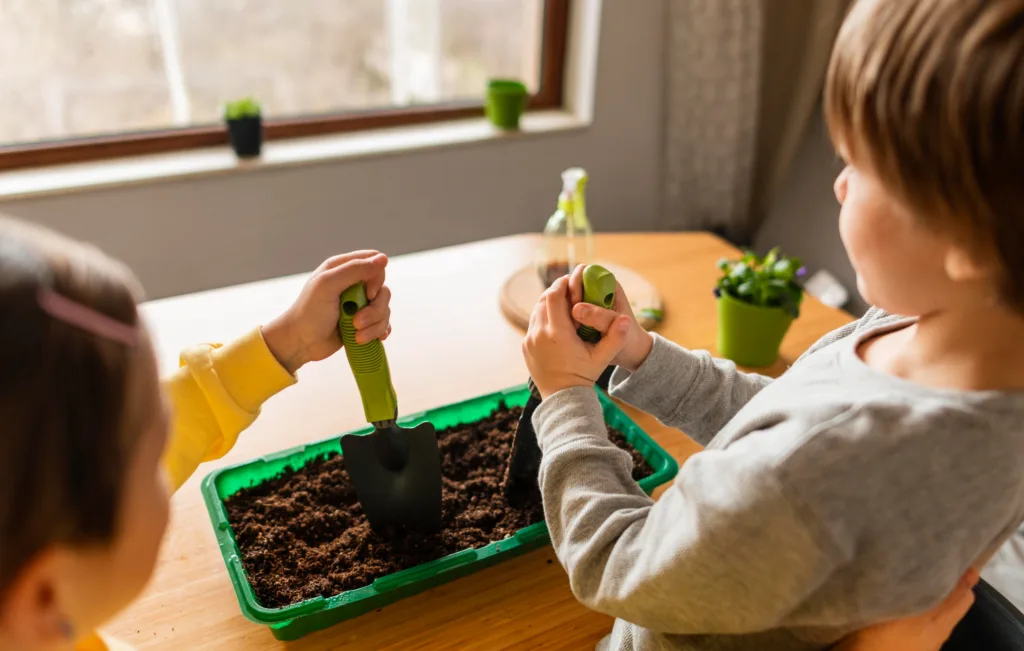
Composting is a valuable lesson for children to learn about organic waste recycling, nutrient-rich soil, sustainable gardening, and the environmental impact of waste disposal. By teaching kids how to compost, we can instill in them a sense of responsibility towards the planet and encourage them to make environmentally conscious choices.
During a composting lesson, gather compostable materials such as fruit and vegetable scraps, coffee grounds, and fallen leaves.
Explain to your children that these materials will break down over time to create nutrient-rich soil, which can then be used to nourish plants in the garden. Encourage them to think about the impact of waste disposal and the benefits of turning organic waste into a valuable resource.
To start composting, designate an area in the garden for a compost bin or create a compost pile. Show your children how to layer the compostable materials, keeping a good balance of green (nitrogen-rich) and brown (carbon-rich) materials.
Explain the importance of regular turning and watering to facilitate the decomposition process. This hands-on experience will help children understand the science behind composting and the crucial role it plays in sustainable gardening.
By actively involving children in composting, we can empower them to become environmental stewards. Composting not only reduces waste and greenhouse gas emissions but also teaches children valuable life skills such as responsibility, resourcefulness, and the importance of working together to create a sustainable future.
Start with easy-to-maintain plants
When introducing children to the world of indoor gardening, it’s important to start with plants that are easy to maintain.
This not only makes the experience more enjoyable for kids but also increases their chances of success in caring for the plants. Some great options for kid-friendly plants include the spider plant, Ponytail Palm, and Pothos plant.
The spider plant (Chlorophytum comosum) is a popular choice for indoor gardening with kids due to its resilience and ability to tolerate a wide range of conditions.
It has long, arching leaves that are green with white stripes, making it visually appealing for children. Spider plants are also known for their air-purifying properties, making them a great addition to any indoor space.
The Ponytail Palm (Beaucarnea recurvata) is another fantastic option for young aspiring gardeners. With its unique appearance, resembling a miniature palm tree, the Ponytail Palm is sure to capture children’s attention.
This plant is incredibly low-maintenance, requiring only occasional watering and bright, indirect light. It’s a great choice for kids who may forget to water their plants regularly.
The Pothos plant (Epipremnum aureum) is an ideal indoor plant for kids due to its resilience and ability to thrive in low-light conditions. It has heart-shaped leaves that come in various shades of green and can even tolerate occasional neglect.
Pothos plants are perfect for teaching children about the importance of regular watering and observing how plants respond to different lighting conditions.
| Plant | Scientific Name | Light Requirements | Watering Needs |
|---|---|---|---|
| Spider Plant | Chlorophytum comosum | Moderate to bright indirect light | Allow soil to dry between waterings |
| Ponytail Palm | Beaucarnea recurvata | Bright indirect light | Allow soil to dry between waterings |
| Pothos | Epipremnum aureum | Low to bright indirect light | Water when the top inch of soil is dry |
Get Creative
Indoor gardening can be a great opportunity for your children to express their creativity and add a personal touch to their plant care routine. Encourage them to get imaginative by using customizable plant pots and personalized decorations.
By allowing your children to decorate their plant pots with fun stickers or paint, you can make the indoor gardening experience more engaging and inspiring for kids of all ages.
Personalized plant decorations not only add a touch of uniqueness to your indoor garden but also provide a sense of ownership for your children.
They will feel proud of their creations and develop a deeper connection with their plants. This creative aspect of indoor gardening enhances the overall aesthetics and makes it a fun and enjoyable activity for the whole family.
To further stimulate your child’s imagination, you can also create themed indoor gardens. For example, they can design a fairy garden with miniature accessories or a jungle-inspired garden with toy animals.
This imaginative approach allows your children to explore different themes while learning about plants and taking care of their indoor garden.
By incorporating creativity into your indoor gardening activities, you not only make the experience more enjoyable but also foster your child’s artistic skills and self-expression.
So, let your children’s imagination run wild and watch as they transform their indoor garden into a beautiful and unique space.
Teach Kids Responsibility
Teaching responsibility to children is an essential life skill that can be instilled through the care and nurturing of plants. By assigning them the task of watering plants, you can help them develop a sense of ownership and responsibility.
Guide them on how to water plants properly, emphasizing the importance of providing the right amount of water without overwatering or underwatering.
Creating a plant care routine can further reinforce the concept of responsibility. Encourage your children to develop a schedule for watering plants and other essential care tasks. This routine will teach them the importance of consistency and discipline in taking care of living things.
Plant Care Ownership
Allowing children to take ownership of plant care tasks not only instills a sense of responsibility but also fosters a deeper connection with nature. As they witness the positive impact of their care on the plants’ growth and well-being, children will develop a sense of pride and accomplishment.
Additionally, involve your children in the decision-making process when choosing plants for your indoor garden. By giving them a say in selecting the plants, they will feel a greater sense of ownership and responsibility for their well-being.
Developing Life Skills
Caring for plants can teach children valuable life skills that extend beyond plant care itself. Through plant ownership, children learn patience as they wait for seeds to germinate and plants to grow. They also develop observation skills as they notice changes in their plants’ appearance and behavior.
Furthermore, plant care encourages children to be nurturing and empathetic. They learn to be attentive to the needs of their plants, providing them with the necessary care and attention. These skills can have a positive impact on their interactions with other living things, including animals and humans.
| Benefits of Teaching Responsibility through Plant Care |
|---|
| 1. Develops a sense of ownership |
| 2. Fosters connection with nature |
| 3. Teaches patience and observation |
| 4. Encourages nurturing and empathy |
Learn about scheduling
As we continue our journey in teaching children about indoor plant care, it’s important to introduce them to the concept of scheduling. Learning to follow a plant care schedule not only ensures the well-being of our green friends but also teaches valuable life skills such as time management and organization.
Creating a plant care calendar can be a fun and interactive activity for children. They can assist in noting down watering and fertilizing tasks, helping them understand the importance of consistency in plant care routines. By involving them in this process, we empower them to take ownership of their responsibilities.
Teaching kids about time management through plant care scheduling sets them up for success in various aspects of their lives. They learn to prioritize tasks, allocate time for different activities, and foster a sense of discipline. These skills will prove beneficial as they grow and navigate through their daily routines.
Furthermore, organizing a plant care schedule also encourages children to develop a sense of accountability.
By taking charge of their plants’ well-being and sticking to a schedule, they experience the satisfaction of seeing the positive outcomes of their efforts. This sense of accomplishment boosts their self-confidence and fosters a sense of pride in their ability to care for living organisms.
FAQ
How can I involve my children in indoor plant care?
You can involve your children in indoor plant care by trying out fun and educational activities such as seed germination experiments, leaf printing art, DIY terrariums, recycling challenges, and composting lessons. These activities help them learn about plants, the environment, and develop a love for nature.
What is a seed germination experiment?
A seed germination experiment involves planting seeds in plastic cups or small pots with potting soil, observing their growth, and learning about the importance of water, sunlight, and air in the germination process.
How can we create leaf printing art?
To create leaf printing art, you need large leaves, washable tempera or acrylic paints, paintbrushes, and paper or canvas. Your children will use the painted leaves to create unique and colorful prints, while also learning about different types of leaves and their contributions to plants and the environment.
What is a DIY terrarium?
A DIY terrarium is a small garden created in a glass or clear plastic container. Your children will use small rocks or pebbles, activated charcoal, potting soil, small indoor plants, and decorative items to create their own mini garden in a sealed environment. This activity teaches them about enclosed ecosystems and the importance of maintaining the right balance of light, water, and temperature for plant growth.
How can we do recycling challenges with plants?
To do recycling challenges with plants, you need empty containers or bottles, art supplies, a timer or stopwatch, and recycling bins or bags. Your children can transform the empty containers or bottles into creative and useful items, such as pencil holders or planters, promoting responsible waste management practices and reducing waste.
What is composting?
Composting is the process of turning organic waste into nutrient-rich soil. In composting lessons, your children will learn about the importance of reducing food waste and how composting contributes to a healthy environment and sustainable gardening practices.
What are some easy-to-maintain plants for kids?
Some easy-to-maintain plants for kids include spider plants, Ponytail Palms, and Pothos plants. These plants are resilient and require minimal care, making them perfect for kids to learn about plant care and responsibility.
How can we get creative with indoor gardening?
You can get creative with indoor gardening by using colorful pots, decorations, and allowing your children to decorate the pots with fun stickers or paint. This makes the indoor gardening experience more engaging and inspiring for kids of all ages.
How can we teach kids responsibility through plant care?
One of the best ways to teach kids responsibility is by giving them a plant to care for. Show them how to pot the plant, water it regularly, and provide specific instructions on plant care tasks. This helps them develop a sense of responsibility, ownership, and learn how to care for something other than themselves.
Why is scheduling important in plant care?
Scheduling plant care activities is important because it teaches kids about time management, organization, and the importance of consistency in plant care routines. Create a plant care calendar where your child can check off watering and fertilizing tasks to help instill these skills.

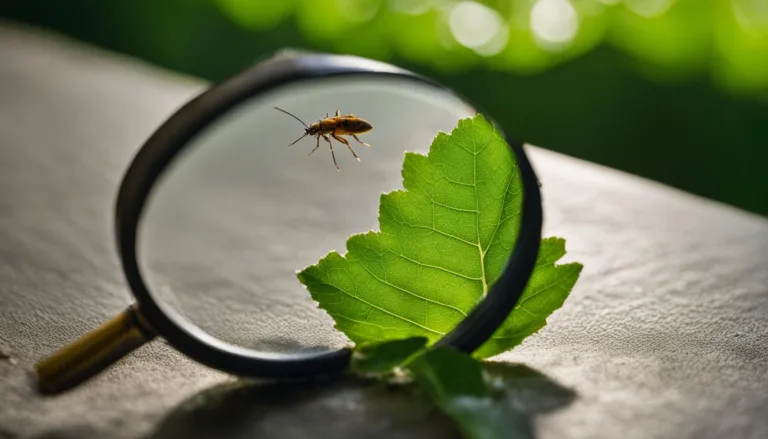
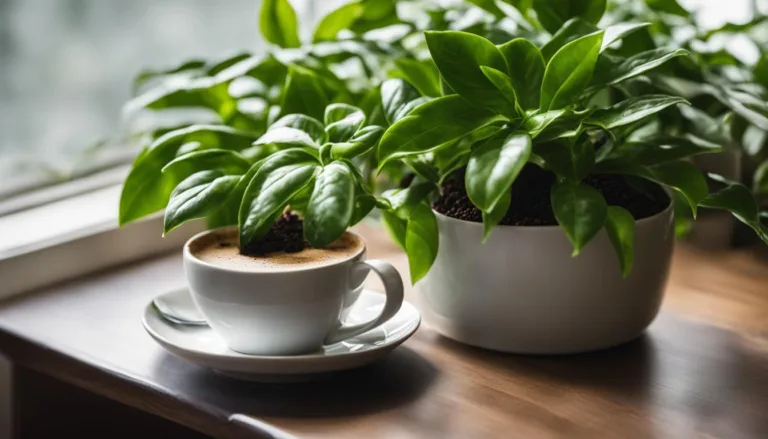
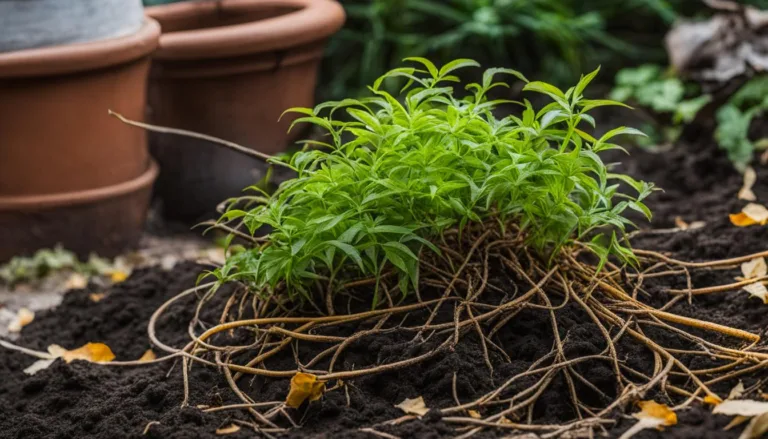
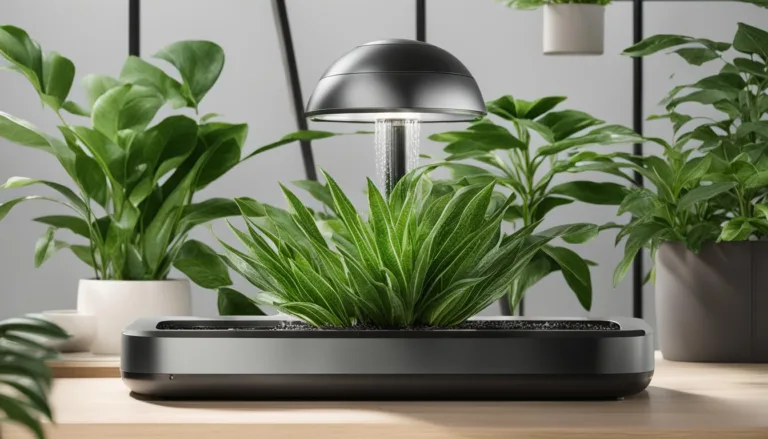
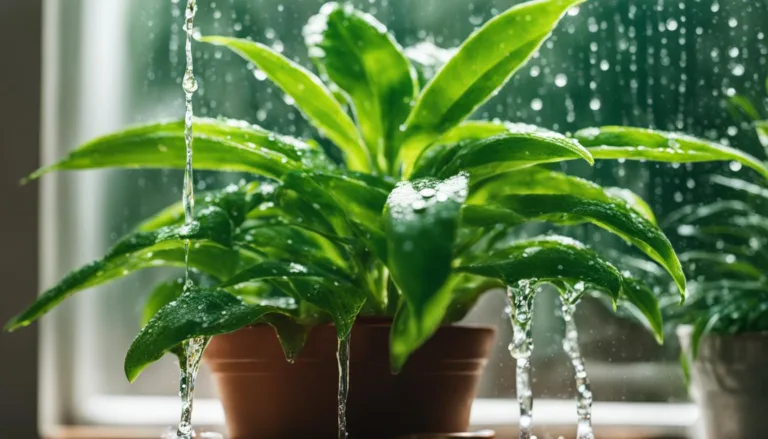
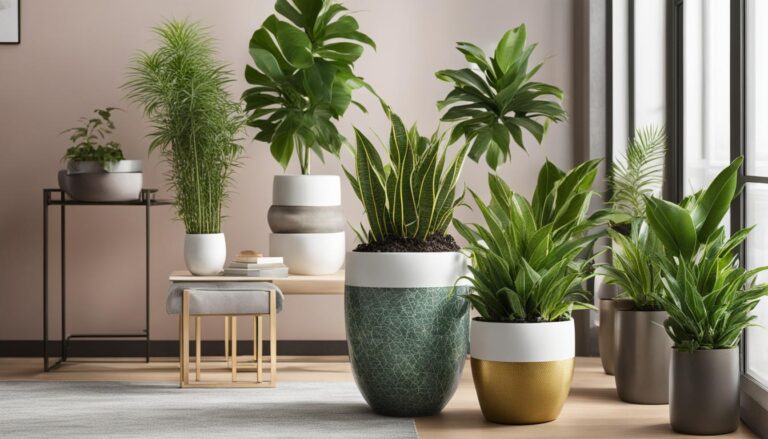
2 Comments
Comments are closed.